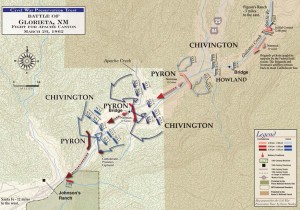 The engagement at Glorieta Pass, New Mexico Territory, fought on 28 March 1862, marked the end of Confederate expansion in the Southwest and the turning point in Brigadier General Henry Hopkins Sibley’s attempt to seize New Mexico. After defeating the main Union forces at Val Verde on 21 February and bypassing Fort Craig, Sibley planned to concentrate his 2,000 Texans near the last Federal outpost, Fort Union, in the northeast corner of the territory.
The engagement at Glorieta Pass, New Mexico Territory, fought on 28 March 1862, marked the end of Confederate expansion in the Southwest and the turning point in Brigadier General Henry Hopkins Sibley’s attempt to seize New Mexico. After defeating the main Union forces at Val Verde on 21 February and bypassing Fort Craig, Sibley planned to concentrate his 2,000 Texans near the last Federal outpost, Fort Union, in the northeast corner of the territory.
A 200-man Confederate detachment stayed at Albuquerque to watch movements by the Fort Craig garrison. A second force of about 350 men under Major Charles Pyron occupied the capital. A third column, composed chiefly of some 800 footsoldiers under Lieutenant Colonel William Scurry, took a circuitous route through the mountains, planning to rendezvous with Pyron near Glorieta Pass in the Sangre de Cristo Mountains east of Santa Fe.
On 26 March, Pyron, proceeding with the rebel plan, blundered into the vanguard of a 1,300-man army of mostly Colorado volunteers under Colonel John Slough at the west end of Glorieta Pass known as Apache Canyon. Pryon, taken by surprise, saw a third of his troops captured while the Federals lost fewer than a dozen before withdrawing. Scurry, alerted to Pyron’s danger, led his men in a freezing night march, reaching Apache Canyon the next morning.

Map of the Glorieta Pass battle courtesy of the Civil War Trust
On 28 March, after a quiet day of waiting, the 1,300-man Federal force divided, with about 450 making a flank march over a rugged mesa to strike the rebel rear while the balance marched down the pass. Scurry, unaware of the enemy plans, left a hundred-man detachment at the mouth of Apache Canyon to guard the wagons, and led the remaining 950 Texans toward Slough’s command in Glorieta Pass.
The two forces met at 11 a.m. near Pigeon’s Ranch. The Federals were thrown back in confusion before taking position around the adobe ranch buildings. The battle raged as a number of disjointed gun duels throughout the afternoon until Scurry ordered a three-pronged attack against the Union line around 4 p.m. The Confederates turned to the Federal right, forcing the Colorado volunteers back to another line farther down the pass. The Confederates did not pursue; darkness ended the battle. Thirty-six Texans had been killed, seventy wounded, and some twenty-five captured, while the Federals counted thirty-eight killed, sixty-four wounded, and about twenty captured.
During the day, however, disaster had struck the rebel rear. The Union flank detachment under Major John Chivington routed the Texan wagon guard at midafternoon, burning some ninety wagons and killing over 800 draft animals. The destroyed supplies constituted the bulk of the Confederate commissary and crippled Sibley’s campaign.
On 29 march, Scurry withdrew his force to Santa Fe, where Sibley and the rest of the army met him. After a week’s delay, the Texans retreated, evacuating New Mexico Territory and Confederate Arizona forever by June. - Donald S. Frazier
[Source: Heidler, David S. and Jeanne T. Heidler. Encyclopedia of the American Civil War: A Political, Social and Military History. W.W. Norton & Co. 2002. pp. 850-851]
Order of Battle
Union
Colonel John P. Slough
Flanking Column
Major John M. Chivington
First Battalion (provisional)
Captain William H. Lewis
5th U.S. Infantry Company A: Lieutenant Barr
5th U.S. Infantry Company G: Lieutenant Norvell
1st Colorado Infantry Company B: Captain Samuel M. Logan
Independent Company of Colorado Volunteers: Captain James H. Ford
New Mexico Volunteers (detachment): Lieutenant Colonel Manuel Antonio Chaves
Main Column
Field Battalion (provisional)
Lieutenant Colonel Samuel F. Tappan
1st Colorado Infantry Company C: Captain Richard Sopris
1st Colorado Infantry Company D: Captain Jacob Downing
1st Colorado Infantry Company G: Captain William F. Wilder
1st Colorado Infantry Company I: Lieutenant Charles Kerber
1st Colorado Infantry Company K: Captain Samuel H. Robbins
Heavy Artillery Battery: Captain John F. Ritter
Light Artillery Battery: Lieutenant Ira W. Claflin
Cavalry Reserve
3rd U.S. Cavalry (detachment): Captain George W. Howland
3rd U.S. Cavalry Company E: Captain Charles J. Walker
1st Colorado Cavalry Company F: Lieutenant George Nelson
Confederate
Lieutenant Colonel William Read Scurry
2nd Texas Mounted Rifles: Major Charles L. Pyron
4th Texas Mounted Volunteers: Major Henry W. Raguet
5th Texas Mounted Volunteers: Major John S. Shropshire
7th Texas Mounted Volunteers: Major Powhatan Jordan
Arizona Rangers: Second Lieutenant William Simmons
Brigands (Santa Fe Gamblers): Captain John G. Phillips
San Elizario Spy Company: Lieutenant J. R. Parsons
Artillery Battery: Second Lieutenant James Bradford
To learn more about the state of battlefield preservation or to tour the battlefield today, visit the Glorieta Battlefield Coalition or the Civil War Trust.
The National Park Service website lists the 150th Anniversary Commemorative Events.
For further reading see:
Edrington, Thomas. Glorieta Pass: The Gettysburg of the West, March 26-28, 1862.
Alberts, Don E. The Battle of Glorieta: Union Victory in the West.
Whitford, William. The Battle of Glorieta Pass: The Colorado Volunteers in the Civil War.


Pingback: This Week in the American Civil War – March 26- April 1, 1862 | This Week in the Civil War
Pingback: Top 10 Civil War Destinations - Marine Corps Times | This Week in the Civil War